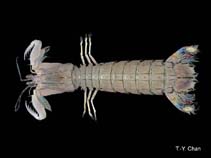Oratosquilla oratoria (De Haan, 1844)
Japanese squillid mantis shrimp| Native range | All suitable habitat | Point map | Year 2050 |

|
| This map was computer-generated and has not yet been reviewed. |
| Oratosquilla oratoria AquaMaps Data sources: GBIF OBIS |
Classification / Names Populärnamn | synonymer | CoL | ITIS | WoRMS
Malacostraca | Stomatopoda | Squillidae
Environment: milieu / climate zone / djupintervall / distribution range Ekologi
; brackvatten; djupintervall 10 - 100 m (Ref. 3099). Subtropical; 46°N - 10°N, 106°E - 144°E
Distribution Länder | FAO områden | Ekosystem | Förekomster | Utplanteringar
Western Pacific: from Vietnam to northern Japan, south to Bohol, Philippines. Introduced to Australia and New Zealand.
Length at first maturity / Size / Weight / Age
Könsmognad: Lm 9.6 range ? - ? cm Max length : 18.5 cm TL hane/ej könsbestämd; (Ref. 3099)
Life cycle and mating behavior Könsmognad | Reproduktion | Lek | Eggs | Fecundity | Larvae
Main reference
referenser | Koordinator | Medarbetare
Manning, R.B. 1998 Stromatopods. p. 827-849. In Carpenter, K.E. and V.H. Niem (eds.) FAO Species Identifidication Guide for Fishery Purposes. The Living Marine Resources of the Western Central Pacific. Vol. 2. Cephalopods, crustaceans, holothurians and sharks. FAO Rome. (Ref. 92)
IUCN Red List Status
(Ref. 130435: Version 2025-1)
CITES status (Ref. 108899)
CMS (Ref. 116361)
Threat to humans
Human uses
Fiskeri: kommersiell
| FishSource | Sea Around Us
Verktyg
Ytterligare information
Max. ages / sizes
Length-weight rel.
Length-length rel.
Length-frequencies
Mass conversion
Abundans
Internet-källor
BHL | BOLD Systems | CISTI | DiscoverLife | FAO(Publication : search) | Fishipedia | GenBank (genome, nucleotide) | GloBI | Gomexsi | Google Books | Google Scholar | Google | PubMed | Tree of Life | Wikipedia (Go, sök) | Zoological Record



